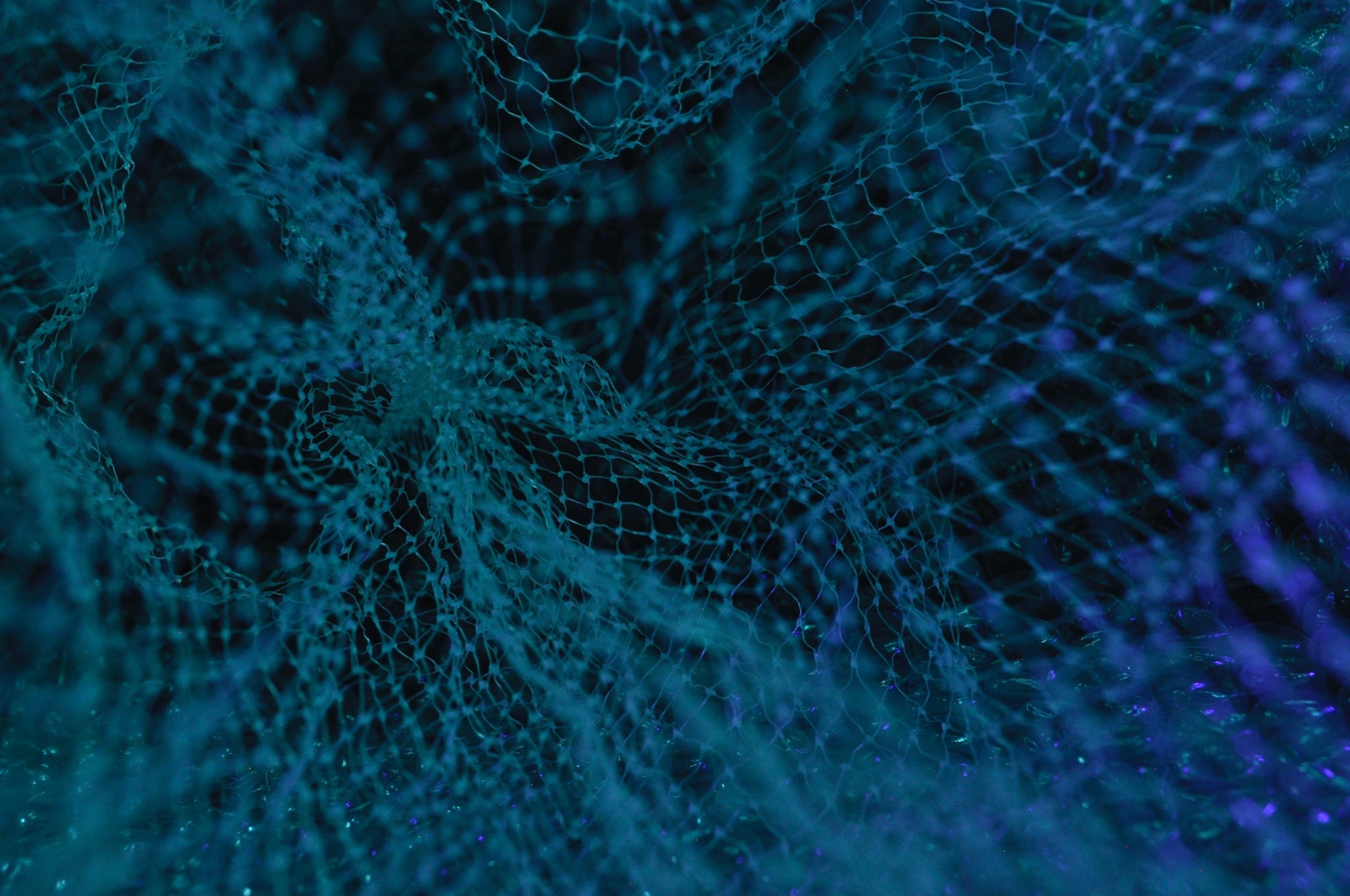I love religious mythology—its poetry and its gravity.
One of my favorites is the Chinese Hua Yan Buddhist myth of Indra’s net. The tale describes a wonderful net hung in the heavenly palace of the God Indra. In every eye of the net, everywhere its threads cross each other, a perfectly round and reflective jewel is sewn. Indra’s palace is infinite in size, so the net is also infinite, so its jewels are infinite in number. Even more remarkable, though, the net is hung in such a precise way that every jewel reflects every other jewel in the lattice. Look at one and you see them all reflected. The effect of this arrangement is awesome: Each jewel reveals and, so, in a sense, contains every other. Changing or removing any one of them changes the entire system of reflections—every other jewel is affected. A natural holism is co-created. And the arrangement has no hierarchy and no start or end points, so no causes or effects. Indra’s net simply is.
Buddhists believe Indra’s net symbolizes the true structure and nature of reality.
Both the image and its philosophical implications resonate with me: Everything is connected. We’re all interdependent. Nothing exists in isolation. And we’re all equally vital.
Recently I was browsing headlines at a cool website called Science Impossible and found a link to a National Geographic article about the IGM—the intergalactic medium. Fascinated by cosmology, I clicked and read. Here are the first two paragraphs of the story:
Much of the missing “normal” matter in the cosmos has been found clustered around wispy ropes of invisible matter spanning the space between galaxies.
The filaments form part of the vast weblike superstructure of the universe, within which galaxies are embedded like sparkling sequins.
The quote’s italics are mine, added to show the place in the article where I started smiling, recognizing a poetic interconnection between the author’s description of the cosmos and Indra’s net!
The parallel is beautiful to me. It’s also compelling—scientific observation lining up with spiritual intuition.
What happens when metaphors become measurables? For me, wonder increases and life becomes richer.



“Everything is connected. We’re all interdependent. Nothing exists in isolation. And we’re all equally vital.”
Need I say more? simple yet complex and vulnerable. I love the story you shared about Indra’s net, so much beauty to it. I really believe in what your trying to start up here with your blog and fully support you! My challenge to you is to challenge yourself in making these ideas accessible to all kinds of people and not just “college educated” folks. you get me? i challenge you to write and lay out your blog in ways that are welcoming to people from all walks of life. in no way am i saying to “DUMB” down the information and dialogue (that would be an insult, cuz i know that college or non college educated people are more than capable of understanding the concepts you share here) but just think about what i am saying and hit me later if you have questions about it 🙂 take care!
Thank you for your comment, Guadalupe! Your challenge to me is definitely my biggest challenge to myself—how to simple things up so anyone can join the conversation… Suggestions welcome…
Very interesting. Never read this myth, even in Joseph Cambell. Your conclusions remind me of Fritjof Capra’s “Tao of Physics.” Very interesting book. I highly recommend reading “Quantum Questions” by Ken Wilber. It’s a collection of essays that you would certainly find fascinating.
Oh ya, I heard a clip on XM many years ago and signed onto your list. Seems that you really are a troubadour!
Thanks, Fred! I found the Indra’s net myth in a wonderful book called HUA-YEN BUDDHISM: THE JEWEL NET OF INDRA, by Francis H. Cook. It eleborates on the idea in really mind-bending ways.
I’ll check out the Ken Wilber book ASAP. Sounds awesome.
Hope you keep enjoying the blog!
That is so beautiful Adam! So you…
Your discussion regarding Indra’s Net called to mind a recent episode of “Nova”: “Hunting the Hidden Dimension”. You said “the net is hung in such a precise way that every jewel relects every other jewel in the lattice…” and that “each jewel reveals and, so, in a sense, contains every other.” Further, there are “no start or end points….Indra’s net simply *is*.”
With fractals, everything looks the same, whether you zoom (way) in or (way) out. Even though the system is contained (like a coastline), it is infinite!
To get more details, you can go to http://www.pbs.org/wgbh/nova/fractals/. For gorgeous pictures of the “Mandelbrot set”, the most famous fractal (named after the mathematician who discovered fractal geometry), you can go to http://commons.wikimedia.org/wiki/Mandelbrot_set and pick your favorite thumbnail to click on.
You mentioned that Indra’s Net is a Buddhist myth. If I am not mistaken, at least one view of the Buddha is that there are *many* forms of Buddha, which can be represented by separate images.
If I am correct in my analysis of one represenation of Buddha, there is one that embraces holism. It has 1000 arms (plus 8 more in some traditions) and eight heads: it is called Avalokite?vara. (See http://www.johnmorello.com/images/1000arms.jpg for an image.) You can almost hear the Buddha meditating on the various aspects of reality in a holistic manner: “On the one hand, yet on the hand, and still on the other hand….” Here is the entry I found on Avalokite?vara at Wikipedia:
“The thousand arms of Avalokite?vara
Avalokite?vara is a bodhisattva (‘enlightenment-being’ who embodies the compassion of all Buddhas. One prominent Buddhist story tells of Avalokite?vara vowing never to rest until he had freed all sentient beings from samsara [the karma wheel]. Despite strenuous effort, he realizes that still many unhappy beings were yet to be saved. After struggling to comprehend the needs of so many, his head splits into eleven pieces. Amitabha Buddha, seeing his plight, gives him eleven heads with which to hear the cries of the suffering. Upon hearing these cries and comprehending them, Avalokite?vara attempts to reach out to all those who needed aid, but found that his two arms shattered into pieces. Once more, Amitabha comes to his aid and invests him with a thousand arms with which to aid the suffering multitudes.
Many Himalayan versions of the tale include eight arms with which Avalokite?vara skillfully upholds the dharma, each possessing its own particular implement, while more Chinese-specific ones give varying accounts of this number.”
To most people, I think, this can be overwhelming, intimidating, even scary. I’m guessing that statue is enough to scare to piss out of some children. By analogy, most adults will be scared of such a mental “image” unless it comes from someone who has been recognize as holy, a genius, or both.
A holistic approach coming from a single, ordinary individual may drive other people away. As one sportscaster on ESPN said to another when he tried to address all sides of a sports issue: “Get off the fence before you hurt yourself.” I, for one, say it is the *responsible* way to *stay* on the fence, to adopt a holistic attitude in approaching the search for knowledge. I say way to go Mr. Daniel!
And again, L.M., thank you!